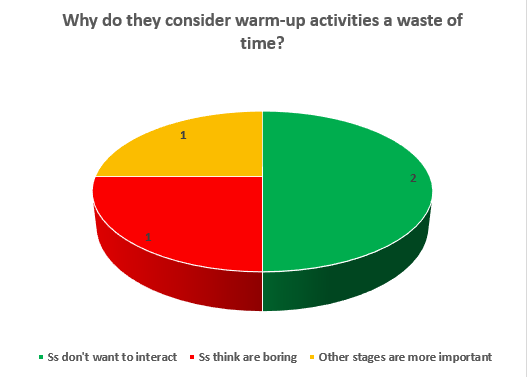Throughout my research, I used teacher observations to evaluate the application of warm-up activities in ESL classrooms. I studied the students’ reactions during and after the warm-up activity, as well as the learners’ performance when the warm-up was not implemented. The data collected was the following:
Classroom 1 was integrated by 25 students. The age of the learners was up to 18 and it was observed for one hour of class. During this lesson, the teacher applied a warm-up activity. She used the activity to review a previous topic. Teacher spent 10 minutes in the activity and the students’ reactions were positive all the time. They interacted each other, they were engaged with the game and had fun. As an overall trend, teacher gave an extra point to the winner to motivate them. After the warm-up, students seemed to be relaxed, most of them showed interest in the following tasks and answered to the teacher’s questions voluntary. They also worked quietly throughout the lesson.
Classroom 2 was integrated by 15 pupils. Their ages were 19 to 21 years old. The class, as well, was observed during one hour. In this class, the teacher integrated a warm-up activity in the lesson. The length of the activity was 14 minutes. Most of the learners were engage with the activity, they participated actively in the activity and some wanted to continue with the activity. After the warm-up, the learners’ interaction was very good, they appeared to be motivated by the lesson and felt free to express doubts and feeling to the teacher.
Classroom 3 was joined by 22 students with different ages. Teacher does not apply a warm-up in the lesson on contrary, he began the class working in the course book. This class showed interest in the topics, learners also answer when teacher requested. However, the class seemed to be monotonous and the students were not motivated enough to work enthusiastically in group or participate voluntarily.
Lastly, I interviewed 15 English teachers from different institutions, the results were the following:
All of the teachers interviewed recognized what are warm-up activities. Also, most of them answered that they consider them an important part of the lesson. Instead, when they were questioned about the frequency they implement such activities in their adult/advanced learners, the majority of them affirmed that they do not use warm-up activities in every lesson. 4 teachers apply them sometimes. A total of 5 teachers enthusiastically acknowledged they apply warm-up activities in each class and 6 teachers said they rarely use warm-up activities in adult learners.

Then, teachers were questioned about the reasons to use warm-up activities in adult learners, having three answers as an option: to activate prior knowledge, to review previous lessons and to have fun. The most popular answer was to activate prior knowledge with 11 replies, three teachers said they use them to review and one teacher apply warm-up activities to have fun in his/her class.

Finally, teachers were interrogated if they consider warm-up activities a waste of time in advanced/adult students. The results were that eleven teachers do not consider them a waste of time and 4 teachers said they do think warm-up activities are a waste of time. Then, they were questioned about the reasons to response yes or no, and the outcomes were that they consider warm-up activities helpful for learners because they get engage with the topic, another answer was they think warm -up motivate students and lastly, pupils can practice the language in a safe environment. Then, teachers who consider them a waste of time answer that some students do not want to participate during such activities, learners consider them boring and practice and production stages are more important in the lesson.





 It is the most widely used primary data collection methods wherein the interviewer asks questions either personally, or through mail or telephone from the respondents to obtain the insights of the problem under study. The researcher may either visit the respondent in person at his home or meet him at the central location as mutually decided by them.
It is the most widely used primary data collection methods wherein the interviewer asks questions either personally, or through mail or telephone from the respondents to obtain the insights of the problem under study. The researcher may either visit the respondent in person at his home or meet him at the central location as mutually decided by them.